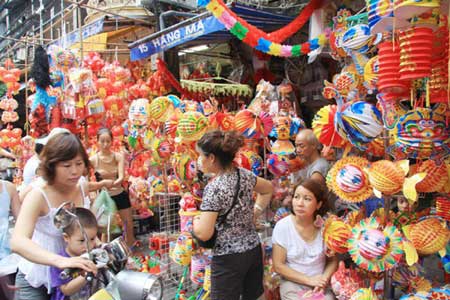A guide to shopping in VN

I'm not usually one to shy away from shopping. In fact, I'd say I'm very partial to the occasional guerilla style sweep of local shopping haunts.
But as a bona fide western consumer I know that it's not uncommon for foreigners – often accustomed to a more rigid and predictable retail environment – to be confronted by a vastly different experience in Viet Nam.
When venturing out into Ha Noi's famed old quarter, it's rare to encounter the scientifically perfected techniques designed to encourage hapless retail victims such as myself into spending more than intended. There are no set prices, comfortable changing rooms or fancy window dresses on these chaotic streets.
Hence why many foreigners are overwhelmed by the prospect of haggling over a pair of counterfeit New Balance sneakers, only inches away from rush hour traffic, hastily stacked shelves bursting with merchandise all the while having the occasional street chicken meander between your legs.
When I arrived in Ha Noi, I was plagued with conflicting feelings. Yes, there was a burning curiosity to discover Ha Noi's bustling retail scene, but there was also a childish fear of an unknown retail landscape so vastly different.
For the first time ever I was actually scared of shopping altogether.
For many, this can often be the case: so many things to buy, so vast a cultural distance keeping them out of reach.
Viet Nam has long been a renowned hub for producing cheap and quality leather goods, art, textiles and shoes. Whilst the initial prospect of shopping amid the chaotic and seemingly lawless streets of the Old Quarter can be overwhelming, the payoffs are there to be made earned.
For the newcomer and western retail-agrophobes, here are some tips for shopping in Viet Nam.
Use basic Vietnamese
Knowing one, or even a couple of basic phrases may disguise your image as a hapless and unwitting cash cow waiting to be slaughtered. For example, even a simple "bao nhieu tien" (how much is this?), or a few light hearted "oi gioi oi" can help you walk away in fabulous counterfeit Vans for as low as US$9.
I'll concede that this won't always work and for those willing to go nuclear you can always try the patented ‘walk away' technique. But try to keep it light and friendly. A smile always helps.
Be prepared to bargain
You don't have to be in Viet Nam very long to realise that street vendors lining the streets of the Old Quarter will charge according to their perception of your ability to pay means-tested prices or, as I like to call it, the ‘foreign premium'.
According to my Vietnamese friends, foreigners can be charged upwards of three to four times normal rates.
A business negotiations lecturer once told me that my BATNA (best alternative to a negotiated agreement) is the buffer between my personal valuation of something and the price at which I would walk away (or a cheaper price I know I can attain elsewhere).
Research roughly how much you should be paying for things you want (your walk away price). Consulting your Vietnamese friends or your tour guide is an ideal way of doing this. Often, if not always, you'll be more confident being able to bargain things down if you know how much its worth.
Learn by example
Whilst I'll admit my retail prowess is yet to fully take flight here, I've had the benefit of good coaching from my Vietnamese friends.
In my first month, a language lesson I organised near Hang Dau Street quickly became an excuse to go shopping and get my tutor to help me bargain for shoes.
Shopping with your Vietnamese friends can be profoundly helpful demonstration of how to bargain, in addition to being a rather amusing social occasion when you're forced to try it for yourself.
Obviously, you should only use these tips when you're shopping around street vendors – i.e. places without printed price tags.
Otherwise, don't look surprised when the assistant at the VinCom perfume counter looks unamused when you try to bargain for a bottle of Aqua di Gio.
Value vs cost
Ultimately, it's inevitable that you'll pay a higher price for something and it can suck to feel like you've been ripped off.
To this, I say that value is in the eye of the beholder (more so for rich travellors than expats being paid in dong). Sure, you paid more than you should have, but how much did you want it? How much less did you pay than you would back home?
Value is in the eye of the beholder and at the very least, knowing how much you value something might soothe the humiliating feeling that you've been swindled, after you've proudly flaunted your counterfeit Ray Ban Clubmasters purchased for VND100,000, only to be told you could have had them for VND20,000.









